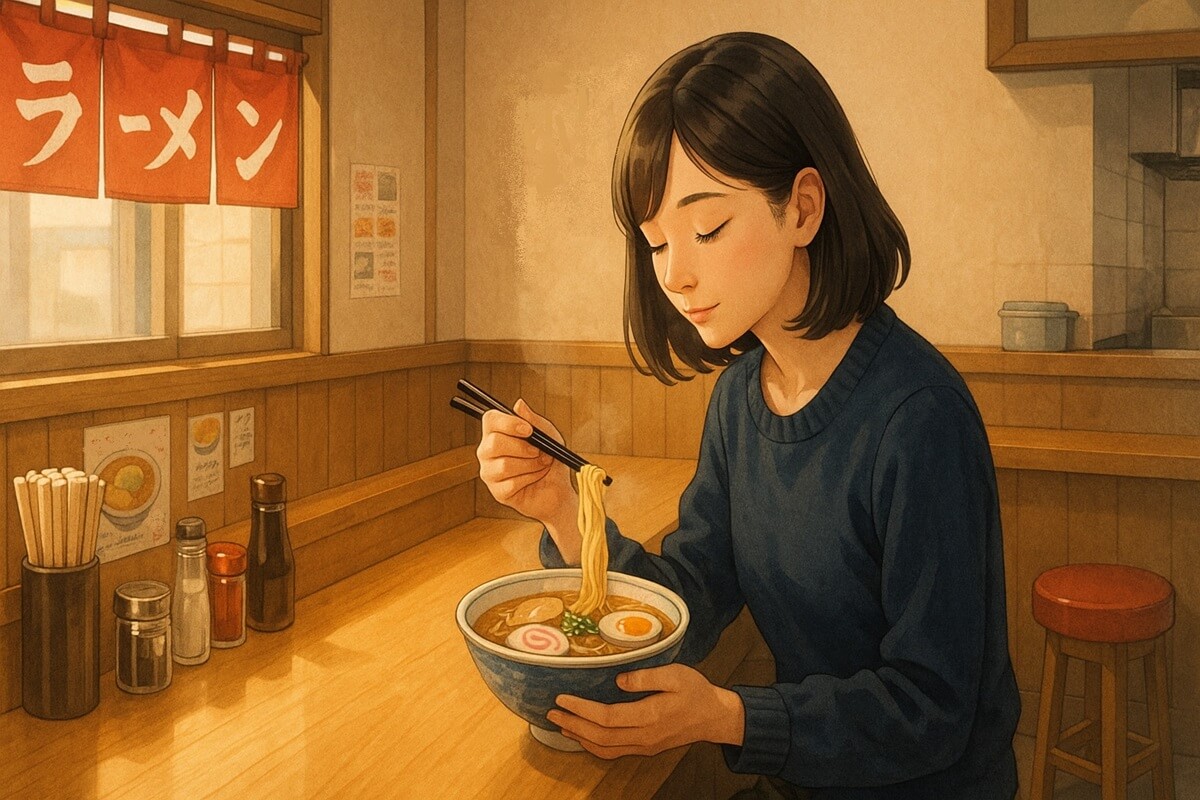
Eating alone in Japan isn’t awkward—it’s completely normal. You’ll notice solo diners of all ages quietly enjoying a meal without hesitation. That’s because the country’s restaurant culture makes it easy. Whether you’re a local grabbing lunch between meetings or just someone who needs a quiet dinner, there’s no stigma—just delicious food.
If you’re curious about where Japanese people actually eat alone on a daily basis, here are the most common spots and why they’re so popular.
1. Ramen Shops
You can’t talk about dining alone in Japan without mentioning ramen. Ramen shops are designed for speed and anonymity. Counters usually face the kitchen so you can enjoy your meal without even making eye contact. Some chains, like Ichiran, even have private booths so you can focus on your noodles entirely without distractions.
Why locals love it: Fast service, consistent quality, and zero social obligation.
Go-to orders: Tonkotsu (pork broth) ramen, extra egg, and spicy red sauce.
2. Gyudon Chains (Beef Bowl Restaurants)
Places like Yoshinoya, Sukiya, and Matsuya serve one specialty: gyudon—thinly sliced beef simmered with onions over rice. It’s fast, cheap, and filling.
Why locals love it: Meals under 500 yen, 24-hour branches, and comforting food that requires no effort.
Go-to orders: Classic gyudon, miso soup set, raw egg on top.
3. Standing Sushi Bars
Forget conveyor belts. Tachigui sushi (stand-up sushi bars) are where locals go when they want quick, fresh sushi without the ceremony of a sit-down meal. You order directly from the chef, eat at the counter, and leave when you’re done.
Why locals love it: Fresh fish without the high price, no tipping, and quick turnover.
Go-to orders: Tuna, salmon, uni (sea urchin), and the daily special.
4. Curry Houses
Chains like Coco Ichibanya and local curry shops are solo-dining havens. Meals are straightforward, quick, and highly customizable—spice level, toppings, and portion size are all up to you.
Why locals love it: Comfort food consistency, full control over portions, and speedy service.
Go-to orders: Pork cutlet curry with cheese and a medium spice level.
5. Kissa and Kissaten-Style Cafes
Not all are meal-focused, but many kissaten (traditional Japanese coffee houses) serve light fare like sandwiches, pasta, or omurice. Locals stop in for a solitary lunch or to relax with coffee and a book.
Why locals love it: Quiet atmosphere, retro vibe, and large tables that make sitting alone with a book feel natural.
Go-to orders: Napolitan spaghetti, tamago sando (egg sandwich), and siphon-brewed coffee.
6. Bento Counters and Depachika (Department Store Food Halls)
Not technically restaurants, but worth mentioning. You can grab a beautifully packaged bento and sit nearby—often on a public bench or in a designated seating area.
Why locals love it: Huge variety, attractive presentation, and no waiting around.
Go-to orders: Grilled fish bento, tonkatsu bento, or sushi sets.
Why Solo Dining Works in Japan
Japanese culture is considerate of personal space. You don’t have to explain why you’re eating alone or feel awkward about it. Restaurant layouts, business models, and cultural norms all make solo dining completely natural. For travelers, it’s also a chance to experience daily life without the tourist filter.
Pro Tips for Solo Diners in Japan
- Look for restaurants with ticket machines outside—they’re fast and solo-friendly.
- Don’t worry if you don’t speak Japanese—pointing at photos or using Google Translate works fine.
- Try going off-peak if you’re anxious—2–5 PM is usually quiet in most eateries.
Dining solo in Japan is not only tolerated—it’s part of the culture. Whether you’re slurping noodles in a private booth or grabbing sushi at a stand-up bar, it’s your chance to find calm amid the city’s buzz.
So go ahead—grab that counter seat. You’ve got this.



